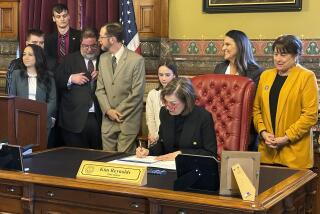Controversial Welfare Plan Resurrected : Benefits: Wisconsin’s governor saves program that boosts payments for teen-age parents who wed. Aid would be cut if they then have more children.
- Share via
MADISON, Wis. — Gov. Tommy G. Thompson has decided to ignore the Legislature and resurrect an experiment that would provide monetary incentives for teen-age parents to wed and penalize them if they have more children while on welfare.
The plan was eliminated by the Democrat-controlled Legislature when it passed the 1991-93 state budget last month, but the Republican governor restored it before he signed the budget Thursday.
“We need to do all we can to remove the disincentives that discourage the development of families, to promote self-reliance and to give people incentives to strive to reach their potential,” Thompson said.
Lawmakers had argued that the experiment would lead to “shotgun marriages” among teen-agers who were not ready to be married.
The plan, dubbed “bridefare” by its critics, would alter Aid to Families with Dependent Children benefits for teen-age parents, eliminating increases they now receive if they have more children.
Critics argued also that freezing those benefits would encourage mothers who became pregnant while on welfare to seek abortions because they will not be able to afford another child.
AFDC is federally funded but administered differently in each state. Wisconsin still needs a waiver from the federal government before it can begin the experiment next year in four counties, including Milwaukee County, where more than half of the state’s welfare cases are based.
Thompson, a close political ally of President Bush, used his partial veto power to restore the plan, which he said is needed to remove provisions in current welfare law that strip a teen-age woman of AFDC benefits if she marries.
Wisconsin’s governor has one of the nation’s most sweeping veto powers and is allowed to eliminate words and numbers to change the meaning of spending bills passed by lawmakers.
The power was upheld recently by the Wisconsin Supreme Court and a federal appeals court. Thompson used it to strike and merge words and numbers in the budget bill to restore his welfare plan.
Since taking office in 1987, Thompson has championed other welfare experiments that have gained national attention.
They include “learnfare,” which penalizes AFDC families whose teen-age children skip school, and “workfare,” which requires some recipients to work part time or undergo job training to keep benefits.
Under the Parental and Family Responsibility Program, the state will increase the monthly AFDC benefits of a teen-age mother to $517 from $447 if she marries the father of her child. The program will also increase the family’s food stamps and job training aid.
Currently, a dependent mother generally loses her AFDC benefits if she marries. Thompson has argued that teen-age families should be allowed to remain on AFDC and receive more money if they marry, until they get the job experience they need to become self-sufficient.
Under the new plan, if the parents have a second child while on welfare, they would receive only half of the current increase for an additional child and would receive no additional AFDC benefits for a third or subsequent babies.
Thompson argues that benefits should be structured to discourage additional births until after a family becomes self-sufficient.
Democrats were incensed by Thompson’s record 457 budget vetoes this year, which far surpassed his record of 290 vetoes in 1987. For the first time in state history, they said, the governor wrote in his own figures for 30 budget items after vetoing the Legislature-approved figures.
State Rep. Barbara Notestein, a Democrat who heads a legislative study committee on teen-age pregnancy, predicted that the plan will force adolescents to marry solely for financial convenience and encourage some women to seek abortions.
“While on the surface, limiting AFDC benefits for a second child may appear to be a good idea, Thompson’s proposal amounts to an abortion incentive,” she said.
“When parents realize they cannot afford to feed, clothe and shelter a child on a reduced grant, they may seek an abortion.”
More to Read
Sign up for Essential California
The most important California stories and recommendations in your inbox every morning.
You may occasionally receive promotional content from the Los Angeles Times.













